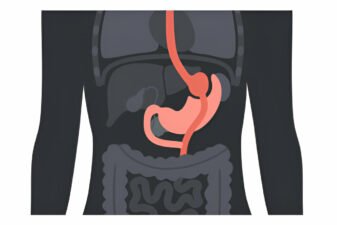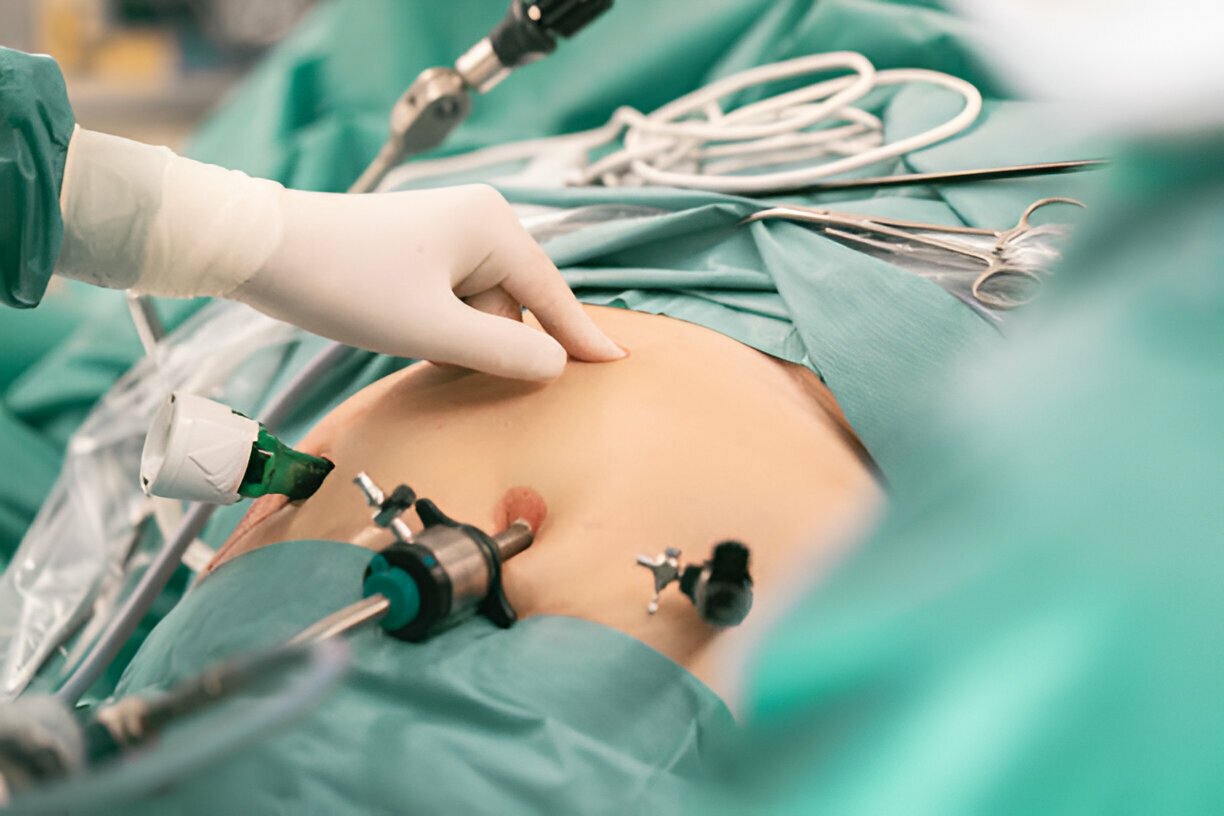Introduction
For some seriously obese patients, bariatric surgery is a last-chance option to improve their health and weight. There are two main types of obesity surgery: stomach banding and stomach bypass, both of which can be performed using traditional “open” techniques or laparoscopy. (During laparoscopic operations, the surgeon makes smaller incisions and views the interior of the abdomen on a video screen which is connected to the operating instruments.) A third type of bariatric surgery is the hybrid procedure known as a two-stage sleeve gastrectomy. This is a lower-risk operation designed for patients with super obesity. Many bariatric surgeons routinely perform a cholecystectomy (removal of gallbladder) during the operation due to the high risk of gallstone disease in severely obese patients. If a prophylactic cholecystectomy is not included, statistics indicate that rapid post-operative weight loss leads to gallbladder disease in about 1 in 3 patients. This morbidity rate can be reduced with the use of ursodiol (ursodeoxycholic acid).
Risks of Surgery vs. Risks of Obesity
Both gastric banding and gastric bypass are serious operations, and (like all major surgery) carry serious health risks. However, the possible risks and health complications of this type of invasive abdominal surgery must be balanced against the known health dangers of morbid/malignant obesity. To begin with an estimated 112,000 deaths per year are directly attributable to obesity. Obese patients have a 50-100 percent increased risk of dying early from all causes, compared to people of a healthy weight. Risk of premature death rises with the degree of obesity. The risk is especially high for those suffering from morbid obesity (BMI > 40) and super-obesity (BMI 50+). Hypertension is twice as common in obese adults, while obesity is an independent risk factor for breast cancer, with 1 in 2 of all breast cancers being diagnosed in obese women. The rise in obesity during the period 1980-2000 has been mirrored by an equal upsurge in type 2 diabetes, with roughly 90 percent of all type 2 diabetics being obese. The risk for diabetes in mildly obese individuals is about twofold, in the moderately obese it is fivefold, in the severely obese tenfold. At the same time, 7 out of 10 diagnosed cases of heart disease occur in obese people. Other obesity-related health conditions include: arthritis, deep vein thrombosis, fatty liver disease, GERD, hypoventilation, insulin resistance and metabolic syndrome, lower limb ischemia, low back pain, sleep apnea, stress incontinence and stroke.
What are the Health Risks of Bariatric Surgery?
The risks vary according to patient-health, the type of gastric surgery performed, the technique used, as well as the skill and experience of the bariatric surgical team. The number of hospital deaths following bariatric surgery is less than 1 percent, while roughly 1 in 5 patients require re-hospitalization for corrective treatment. In general, mortality and morbidity rates of follow-up operations are higher than those of initial surgeries.
Health Risks Of Restrictive Surgery
Health complications of restrictive procedures (like adjustable gastric banding and vertical banded gastroplasty) are typically infrequent. Even so, patients must be informed that early morbidity from infection and bleeding can be as much as 10 percent and from deep venous thrombosis, 2 percent. The fatality risk is less than 1 percent. Long-term health complications of restrictive bariatric procedures include severe GERD, stomal stenosis, gastric prolapse, band erosion or migration, and staple line dehiscence.
Health Risks Of Purely Malabsorptive Surgery
Bypass operations which contained no restrictive element (ie. no reduction in stomach size) such as the jejunoileal bypass, were the early type of weight loss surgery, and they dominated bariatrics from the 1950s to the 1970s. Their single objective was to bypass a major portion of the absorptive surface of the small intestine (ie. the part of the digestive system that absorbed vitamin and mineral nutrients from food). The advantage of these purely malabsorptive procedures was rapid, sustained weight loss without any need for changes in eating habits. Unfortunately the disadvantages were significant and included severe metabolic complications, severe nutritional deficiencies, oxalate-induced nephropathy, steatorrhea, and late-onset liver failure with cirrhosis. As a result, these purely malabsorptive procedures are no longer performed.
Health Risks Of Combined Malabsorptive and Restrictive Surgery
Health complications of the combined operations like gastric bypass (eg. Roux-en-Y, Biliopancreatic Diversion, Duodenal Switch) include a mortality risk of less than 1 percent and a disease rate of about 10 percent. The latter can be serious and include afferent limb obstruction with gaseous distention of the stomach as well as post-operative leaks with peritonitis and subsequent abdominal trauma. Other serious health complications include internal hernias that involve the Roux limb passing through the mesentery can also cause severe morbidity. This is a more common risk with laparoscope-assisted surgery. Less severe health complications include stomal stenosis (typically amenable to endoscopic dilation) and marginal ulcers, which are treatable with acid suppression therapy. Due to the reduction in nutrient uptake, caused by the bypass of the small intestine where most vitamins and minerals are absorbed, nutritional deficiencies will occur and will lead to long-term complications if patients do not continue with vitamin and mineral supplementation. After most stomach bypass operations, lifelong vitamin B12 injection therapy and a daily multivitamin are mandatory. In addition, calcium and iron supplementation is often needed.
Assessing The Risks Of Bariatric Surgery
To qualify for bariatric surgery, candidates must either be morbidly obese (BMI 40+) – which itself carries a significant additional risk of disease and premature death – or seriously obese (BMI 35+) with a serious comorbid condition. In addition, all bariatric candidates must demonstrate a proven inability to lose weight and improve their health using conventional weight loss programs. Thus surgical treatment is only available to patients with serious weight-related health problems, whose physical and emotional quality of life is seriously impaired. The risks of bariatric operations, when viewed against this background, are relatively acceptable, even though the long term success of any banding or bypass operation remains firmly in the hands of the patient.
Stomach Stapling
Gastric stapling surgeries, like vertical banded gastroplasty, are slightly easier to perform and carry a lower risk of post-operative complications than stomach bypass. Furthermore, vertical banded gastroplasty typically produces more effective weight reduction than adjustable banding procedures that only use a gastric band or ring, instead of staples. However, some bariatric clinics report an unacceptable level of heartburn and problems with food returning up into the esophagus. Stomach stapling remains less effective than stomach bypass.
Risks of Stomach Stapling
These include:
– Breakage of staples
– Heartburn
– Risk of vomiting if food is not properly chewed
– Some risk of nutritional deficiencies
– Reduced weight loss due to non-compliance with diet and exercise guidelines
Lap Band Risks And Problems
Like stomach stapling, adjustable gastric banding is a less drastic procedure, therefore more popular than bypass operations. However, patients can “cheat” more easily, thus weight reduction tends to be smaller. Typically, weight loss with the band is exceptionally variable. Some patients achieve excellent weight loss with their Lap Band, while others achieve very little.
In addition, the band is a foreign body, and when placed around the stomach can cause problems like infection or erosion. These are not serious health problems but may be discomforting and impact adversely on patient satisfaction.
The risk of band slippage is another problem due to a combination of movement and eating habits. All lap-band patients need several band adjustments (typically a minimum of 4), while some require many more adjustments. It may be difficult to position the band so that it’s tight enough for effective weight loss but not so tight that it causes vomiting. Some bariatric centers report that gastric banding has an unacceptable rate of severe heartburn and vomiting.
The risk of corrective surgery and reoperation appears to be higher with gastric banding than with other bariatric procedures. Up to 10-20 percent of band patients may need revisional surgery after the Lap-Band.
Risks of Lap Band: Summary
– Band slippage/leakage
– Heartburn and vomiting
– Risk of internal infection
– Stomach pains after meals (over-eating)
– Nutritional deficiencies during liquid diet
– Reduced weight loss due to non-compliance with post-operative dietary and exercise guidelines










